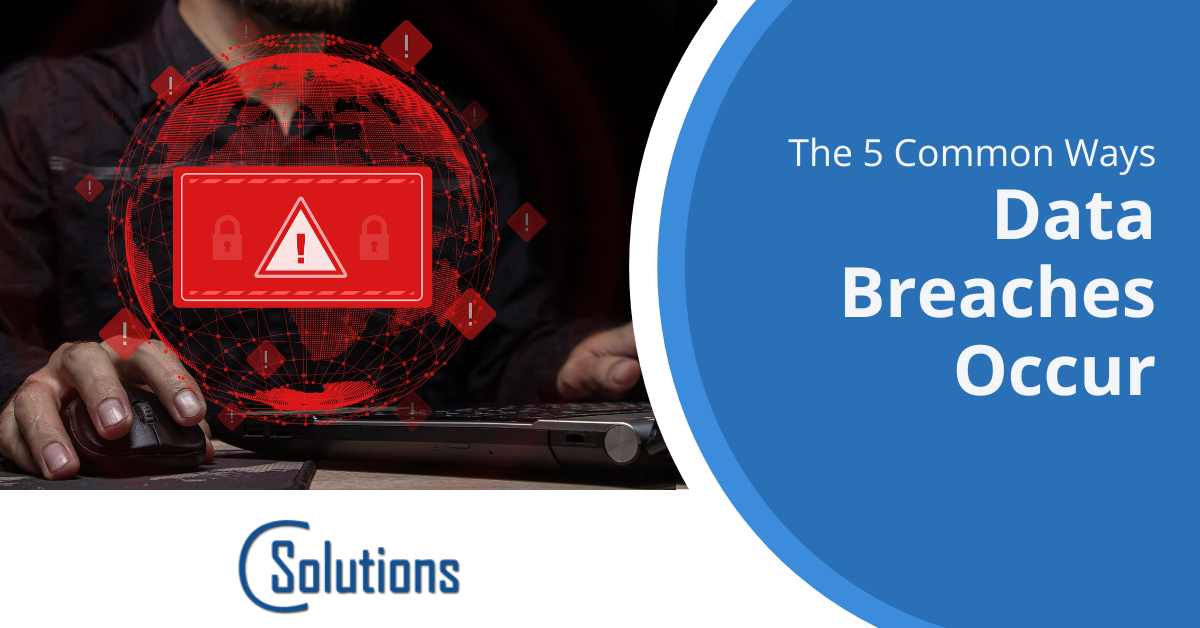The 5 Common Ways Data Breaches Occur

Most of the time, a data breach is not just a temporary error. It can be the end of an organization. Imagine waking up one morning to find out that sensitive information belonging to your or your customers has been exposed. The costs that come in the aftermath are often too much for smaller companies to bear.
Hackers can use various methods to get at you (internet, email, social media, text messages, and even phone calls). Thus, it doesn’t matter if you are online or offline. In the absence of attentiveness to details, hackers can identify vulnerabilities in a system and cause a data breach.
Unfortunately, many people are not informed on how these data breaches can occur. As such, they do not deploy adequate protections.
Does your organization want to tackle data breaches? It is best to identify the common causes of such a breach.
We’ll explain data breaches, the common ways they occur, and how to prevent them.
What Is a Data Breach?
A data breach can be defined as exposing confidential information to an unauthorized person. In this way, the files are shared or accessed without the appropriate permission.
As mobile devices connect to various sources with ease, it becomes effortless for data to get into the wrong hands. Unfortunately, new work technologies spring up at an alarming rate, and little attention is paid to configuration patterns.
In the same vein, many intelligent products are introduced to the marketplace without encryption. Hackers are taking advantage of this gaping flaw to manipulate unprotected devices.
5 Common Ways Data Breaches Occur
There are several assumptions about how data breaches occur. Many people assume that hackers only cause data breaches. It is not entirely true. Data breaches can sometimes be a product of oversight or a loophole in the company’s structure. Verizon describes some of the different ways data breaches happen as:
1. Criminal hacking
This remains the top cause of data breaches. The hackers can purchase a company’s credentials from the Dark Web and use a password-generating machine to access the company’s information. Armed with this information, hackers can commit fraud, phishing scams, or even launch further attacks on the company.
2. Human error
Breaches are also the product of human error. If your employees make a mistake, sensitive information can get into the wrong hands. This may include sending an email to the wrong person or sending data to an individual who shouldn’t have access to it. Another common mistake employees make is leaving a database online without creating a password.
3. Malware
Cybercriminals make use of malware for various purposes. A prominent type is the use of RAM scrapers. Cybercriminals use this method to collect sensitive information from digital devices. Unfortunately, Point-of-sale (POS) devices are highly vulnerable to it. Cybercriminals also use keyloggers to identify the inputs that were used on a keyboard. With this, they will access various passwords and other vital information.
4. Social engineering
Phishing is a common way hackers get at unsuspecting individuals. They send out emails that seem legitimate under the pretense of getting the attention of their target. These emails often contain links to malicious sites that can download malware or steal login credentials. As soon as the attackers have the information they want, they can either sell it to a third party or use it to commit fraud.
5. Theft
Another cause of data breach is theft. If any item such as laptops, phones, or hard drives that contains sensitive information about your organization gets missing, this can result in a data breach. Unfortunately, if the volume of information on such items is large, this will cause the organization to witness a severe data breach. Most times, it is difficult to predict the theft.
A laptop is stolen every 53 seconds.
How to Prevent Data Breaches
Data breach prevention is not reserved for a selected few. This presupposes that it must involve all employees at all levels.
When trying to prevent a data breach, you must recognize that anyone who interacts with the system is a potential threat. As such, do not leave any stone unturned. So, some of the best practices to help prevent data breaches are:
- Update software as soon as there is the latest version
- Upgrade your devices
- Educate your employees
- Enforce multiple-factor authentication
- Make use of security policies
Stay On Top of Preventing Data Breaches
The price for enabling loopholes in your company’s infrastructure is too high. You can’t afford to make such a mistake and become susceptible to malicious attacks. The ideal way to protect your business is to secure it with the proper solutions.
Need help getting an effective cybersecurity solution for your organization’s data? Contact us at 407-536-8381 or reach us online.
